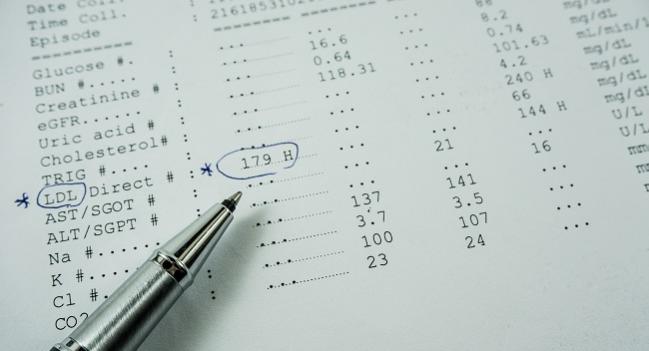High LDL and Non-HDL Cholesterol Tied to CV Mortality Even in Low-Risk Individuals
New research suggests that cholesterol-lowering interventions could be useful even in people with a 10-year ASCVD risk below 7.5%.

For patients with a projected 10-year risk of atherosclerotic cardiovascular disease (ACSVD) below 7.5%, elevated LDL and non-HDL cholesterol levels can still translate into greater long-term risks of dying from cardiovascular or coronary heart disease, according to new observational data.
Low-risk individuals with a LDL cholesterol level at 160-189 mg/dL saw a 70% increase in risk of CVD mortality and an 80% increase in CHD mortality in the study. Risks were highest in those with non-HDL cholesterol levels of 190-219 mg/dL.
According to the 2013 American Heart Association/American College of Cardiology guidelines, statin treatment is advised for low-risk patients when their LDL cholesterol levels are at or above 190 and may be considered at levels of 160 or above. However, there is some disagreement about these guidelines in clinical practice, says lead author Shuaib Abdullah, MD (UT Southwestern Medical Center, Dallas, TX).
“Unlike most of their other recommendations, the evidence for those [guidelines] is probably the weakest,” he said. “There is a lot of controversy of what threshold to use in these low-risk people for treating cholesterol,” with some physicians being against medical therapy in this population.
The new results, published this week in Circulation, were derived from the Cooper Clinic Longitudinal Study (CCLS), a long-term observational study in Dallas, TX, including over 100,000 participants that tracks long-term cardiometabolic outcomes.
Abdullah and colleagues focused on 36,375 individuals with an estimated 10-year ASCVD event risk of less than 7.5% who initially enrolled in the CCLS program from 1978 to 1998 and were followed until 2014. During the study period, there were 1,086 deaths attributed to CVD and 598 deaths attributed to CHD.
After adjusting for sex, HDL cholesterol, and ASCVD risk factors, the researchers found that as LDL and non-HDL cholesterol levels increased, the risk of death due to CVD or CHD increased incrementally. After lowering the estimated ASCVD 10-year risk from 7.5% to 5%, the relationships remained the same.
CVD Death in Individuals With 10-Year ASCVD Risk ≤ 7.5%
|
|
Adjusted HR |
95% CI |
|
LDL, mg/dL |
||
|
100-129 |
1.3 |
1.01-1.6 |
|
130-159 |
1.2 |
0.9-1.4 |
|
160-189 |
1.7 |
1.4-2.2 |
|
> 190 |
1.5 |
1.2-2.1 |
|
Non-HDL, mg/DL |
||
|
130-159 |
1.2 |
0.97-1.4 |
|
160-189 |
1.3 |
1.1-1.6 |
|
190-219 |
1.8 |
1.4-2.2 |
|
> 220 |
1.5 |
1.2-2.0 |
CHD Death in Individuals With 10-Year ASCVD Risk ≤ 7.5%
|
|
Adjusted HR |
95% CI |
|
LDL, mg/dL |
||
|
100-129 |
1.2 |
0.9-1.6 |
|
130-159 |
1.2 |
0.9-1.7 |
|
160-189 |
2.2 |
1.6-3.0 |
|
> 190 |
2.0 |
1.4-2.9 |
|
Non-HDL, mg/dL |
||
|
130-159 |
1.4 |
1.04-1.8 |
|
160-189 |
1.8 |
1.4-2.3 |
|
190-219 |
2.6 |
1.9-3.4 |
|
> 220 |
2.2 |
1.5-3.1 |
“These analyses indicate that there is no ‘threshold’ at which atherogenic lipoproteins increase ASCVD risk,” write Christie Ballantyne, MD and Salim Virani, MD, PhD (both Baylor College of Medicine, Houston, TX), in an editorial commenting on the study. “Even moderate elevations in atherogenic lipoproteins, without other risk factors and with a low 10-year ASCVD risk, are associated with increased long-term risk of CVD mortality and possibly all-cause mortality.”
These results challenge traditional thinking about risk of cardiovascular disease in low-risk populations, and could suggest earlier intervention is necessary, the editorialists say. The data raise “questions of whether the 10-year of lifetime ASCVD risk assessment should be performed first in individuals with LDL cholesterol 160 to 189 mg/dL or whether they should begin lipid-lowering treatments based on long-term risk similar to individuals with LDL cholesterol levels > 190 mg/dL,” they add.
Generally, target non-HDL cholesterol levels are equivalent to a patient’s LDL level plus 30 mg/dL. Previous studies of higher-risk groups have found non-HDL to be more predictive of risk compared to LDL cholesterol, the authors write. Here, too, non-HDL was linked to sharper increases in risk compared with corresponding LDL levels.
“LDL is commonly referred to as bad cholesterol, but there's some other subfractions in the total cholesterol measurement that LDL doesn't account for, such as very low-density lipoprotein, intermediate density lipoprotein, and remnant particles,” Abdullah told TCTMD. “All these subfractions of total cholesterol have shown to be associated with worse cardiovascular prognosis.”
Surprisingly, the highest levels of LDL and non-HDL cholesterol were associated with lower risk than levels directly below them. This is likely because individuals with the highest cholesterol levels were later treated with statins, when the medication become more widely prescribed after 2000, Abdullah said. Researchers were unable to account for medication initiated during this study period.
An additional limitation of this study is the participant population—individuals enrolled in CCLS tend to be of a higher education level and socioeconomic status and are generally health-conscious, Ballantyne noted to TCTMD. However, in a way this serves as a strength of the study as well, he added. “Even in people who are quite healthy with low cardiovascular risk, there is still long-term predictive value of LDL- and non-HDL cholesterol.”
Low-risk individuals should still be wary of higher cholesterol levels and discuss lifestyle and potential medical treatments with their physicians, Ballantyne advised.
“There is a gigantic amount of data for cholesterol, but I would say an urban myth is that if you exercise, and if you are fairly healthy, it doesn’t cause any problems. This study shows is that yes, in fact, there is an issue,” he said.
Lucy Hicks is the 2018 recipient of the Jason Kahn Fellowship in Medical Journalism. She is currently a master’s student…
Read Full BioSources
Abdullah S, Defina L, Leonard D et al. Long-term association of low-density lipoprotein cholesterol with cardiovascular mortality in individuals at low 10-year risk of atherosclerotic cardiovascular disease. Circulation. 2018;Epub ahead of print.
Virani S, Ballantyne C. Low-density lipoprotein cholesterol: is 160 the new 190? Circulation. 2018;Epub ahead of print.
Disclosures
- Abdullah reports no relevant conflicts of interest.
- Ballantyne reports receiving grant support from Amgen, Esperion, Regeneron, and Synthelabo, on the institutional level. He also serves as a consultant for Amgen, Esperion, Merck, Regeneron and Sanofi-Synthelabo.


Comments